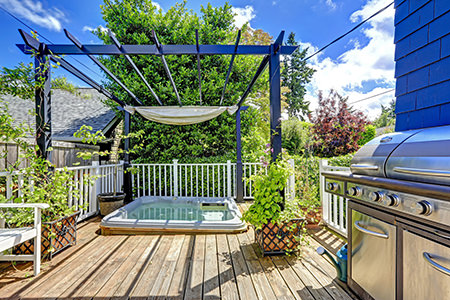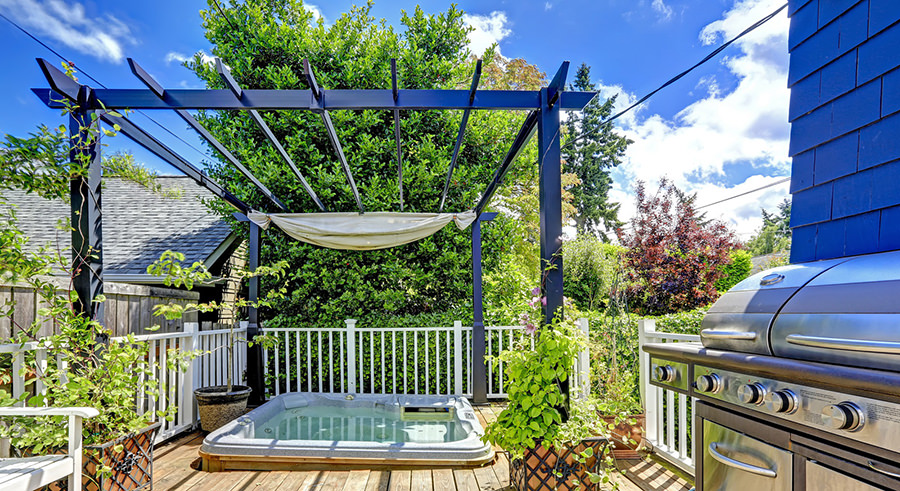
It’s a great testament to how times have changed in that, unlike even ten years ago, the eco credentials of any product are now considered as one of the most important factors in the purchasing decision. You could very easily argue that it’s now too little too late but the tide is turning and many people will not buy products or engage in activities that they consider to be environmentally unfriendly.
So, the question is, how does buying or owning a hot tub fit into this? On the face of it owning a huge plastic bathtub, filling it with hundreds of gallons of water and chemicals and constantly heating it up doesn’t sound all that environmentally friendly. Are there ways to get around this and can you own a hot tub and also minimise the impact on the environment? It would be lovely to be able to relax in your hot tub guilt free – but is it really possible? I decided to research and find out:
So, are hot tubs environmentally friendly? Modern hot tubs are much more eco or environmentally friendly than old ones. They are much more energy efficient and are also more likely to use recyclable materials. It is possible to use more eco chemicals and also to take steps to minimize energy usage or to run your hot tub from solar power. Hot tubs use little water compared to the average daily household usage, their main eco credentials lie in how energy efficient they are.
What is a hot tub’s environmental impact?
There are several areas throughout the life of a hot tub where it will potentially have an impact on the environment. Some of these are essentially out of the control of the owner, such as how the hot tub was made or transported, but others, particularly when it comes to the day to day running of the hot tub, where the owner can have much more control. Let’s have a look at each of these factors in turn:
Hot tub manufacturing and the environment – In the traditional manufacture of a hot tub, the shell is formed first from acrylic and then heated in an oven to around 300 degrees until it becomes malleable enough to be moulded into shape. Traditional fibreglass or acrylic really isn’t environmentally friendly but there are now much more eco-alternatives that manufacturers are starting to use. High-density polyethelyne can now be used in conjunction with rotational moulding techniques to produce a hot tub shell that is tough, durable, lightweight and most importantly recyclable. This does away with the old issues of handling fibreglass and resins and the volatile organic compounds that can be created and become toxic if they are not handled correctly.
Apart from the hot tub shell, heating elements, pumps and electronic equipment are all also other potential areas where recyclable materials may or may not be used. The processes by which they are designed and built will also have a varying impact upon the environment depending upon the manufacturer and the specification. Increasingly manufacturers are using more eco components and sourcing materials from sustainable sources but it is always worth checking before you buy.
Transportation – A hot tub is a large, awkward and very heavy product to transport around and, depending upon where you live, a proportion of the hot tub’s price will be allocated to the huge transportation cost of getting the hot tubs to your local distributor. Obviously, if the hot tubs are built in the same area or country in which you purchase it then the carbon footprint will be much lower as there will be less transportation involved.
Environmentally speaking it is best to buy as local as possible to cut out as much of the environmental costs of transportation as you can . Bear in mind that you could buy a relatively environmentally friendly hot tub from your local dealer only to find that it has been transported hundreds or even thousands of miles to the dealership which, to a certain extent defeats the object of the exercise!
Water consumption – This is one area where most people assume that a hot tub isn’t at all eco. We assume that, just because a hot tub holds up to 400 gallons of water, that it isn’t a particularly good or environmentally friendly use of the water, particularly as it needs to be changed at relatively frequent intervals.
To put this in context the average US household uses 400 gallons of water per day. Of this, up to 10 gallons a day is wasted due to leaks, flushing the toilet can use 3-5 gallons and doing a load of laundry between 20 and 40 gallons.
In fact, hot tubs are very water efficient. They constitute less than 1% of an average households water consumption because they only need refilling every 3-4 months and, with careful water management, it’s even possible to use the old hot tub water for washing the car or watering the garden. If you assume that you would do these activities anyway then the water you save by using the water from the hot tub means that the hot tub’s water usage over the long term is negligible.
Energy consumption – However, it becomes much more difficult to give a hot tub a glowing bill of eco-health when you start to look at energy consumption. Many hot tub owners find that their electricity bills are significantly higher when they are running their hot tubs. You can, of course, try to switch to a 100% green energy supplier but the amount of energy a hot tub uses can still be a considerable expense.
However, the least energy efficient hot tubs tend to be older models which are usually poorly insulated and simply just not particularly energy efficient when it comes to heating and filtering the water. A modern hot tub will have significantly higher thermal efficiency than an older one and will, therefore, use much less energy and be more environmentally friendly. The climate in which the hot tub is situated will also make a big difference. It uses more energy to maintain the temperature of a hot tub in a country where the ambient temperature is low rather than in a hotter climate. A hot tub in Alaska will cost more to heat than one in Florida for example and consequently have a bigger environmental footprint.
If you are interested in how much energy a hot tub actually uses then have a look at my post here.
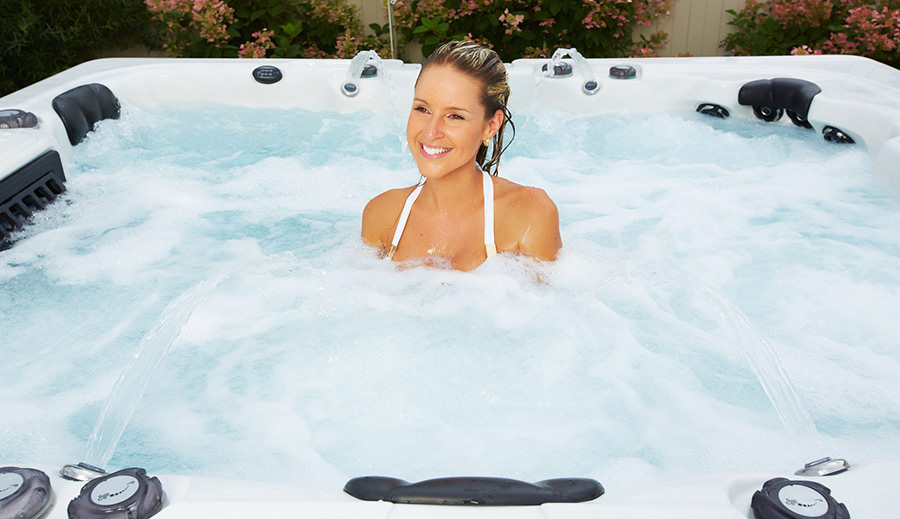
So, apart from having a modern energy efficient hot tub and buying your energy from a greener or greener supplier what else can you do? Well, it’s also now possible to run a hot tub using solar energy and specific solar energy hot tub conversion kits are available. The efficiency of these will vary according to the prevailing weather conditions in your area and you might need to supplement it with a mains electric top up from time to time but solar-powered hot tubbing is an appealing concept and the thought of essentially not paying for the heating of your hot tub is very attractive! Currently, solar powered kits are around the $2000 mark and the manufacturers claim energy savings of up to $900 per year. This means you could recoup your cost of installation in between 2 and 3 years giving you potentially another 10 years or so of “free” heating power for your hot tub. With solar technology improving at a rapid rate this has to be well worth investigating and a viable alternative and green energy supply for hot tub owners.
Hot tub Sanitizers – OK, well there’s little doubt that most traditional hot tub sanitizers aren’t particularly environmentally friendly. You are basically sitting in a chemical bath and, as long as the chemicals are used properly and all of the maintenance instructions are adhered to they are safe, but even the idea of it is unpleasant for some people. Chemical sanitizers can also cause skin and breathing irritation and then there is the problem of what to do with the water when it’s ready for changing. If you want the lowdown on chlorine and bromine then have a look at my detailed comparison post here.
Well, the good news is that both Chlorine and Bromine, which are by far the most commonly used chemical sanitizers, decay over time. This means that the water will be relatively free of the chemicals of you don’t add any more for a few days before disposing of it. It’s also good news that using chemicals to prolong the life of your water between changes is better for the environment than changing a full 400-gallon hot tub’s water every week or so which is what you would have to do if you didn’t use chemicals at all.
However, are there any more environmentally friendly and more natural alternatives? Well, luckily there are but, unsurprisingly they are more expensive.
Saltwater sanitization systems – You can change to a saltwater sanitization system which basically utilises the reaction between the salt and the warm water in the hot tub (electrolysis) to create natural chlorine. This comes without the disadvantages of traditional chlorine such as skin irritation and smell but can cause corrosion to the hot tub, is expensive to buy and the salt cells need to be replaced periodically as well.
Ultraviolet sanitization systems – UV is a physical rather than a chemical process and as such, is the cleanest and most environmentally sound solution around. Basically, the water is pushed through tubes where it is zapped with UV which kills anything in it’s path. Disadvantages are price and also the fact that you will still need to shock the tub occasionally as the process doesn’t help with water clarity at all but you need to do this significantly less than with traditional chemical systems.
Ionizer sanitization systems – Again, this is a more eco alternative than using traditional chemicals and works by releasing copper and silver ions into the water to kill bacteria. The tub will still need periodic shocking to keep good water clarity and to prevent cloudiness but it uses significantly less chemicals than the traditional chemical systems.
Ozonator sanitization systems – A hot tub ozonator adds ozone to the water in your hot tub which then kills bacteria. The amount of ozone produced is minimal so the environmental impact is relatively small. Again this system will need to be used in conjunction with small amounts of shock treatment to keep the water completely clear.
Hot tub afterlife/recycling – Finally, a hot tub will potentially have a large environmental impact if none of it’s parts are recyclable or if the owner doesn’t dispose of it responsibly. Increasingly hot tubs are being designed to be easily disassembled and recycled at the end of their working lives. The very worst scenario is the thought of a hot tub, with all of it’s mechanics and working parts sitting for eternity in some landfill.
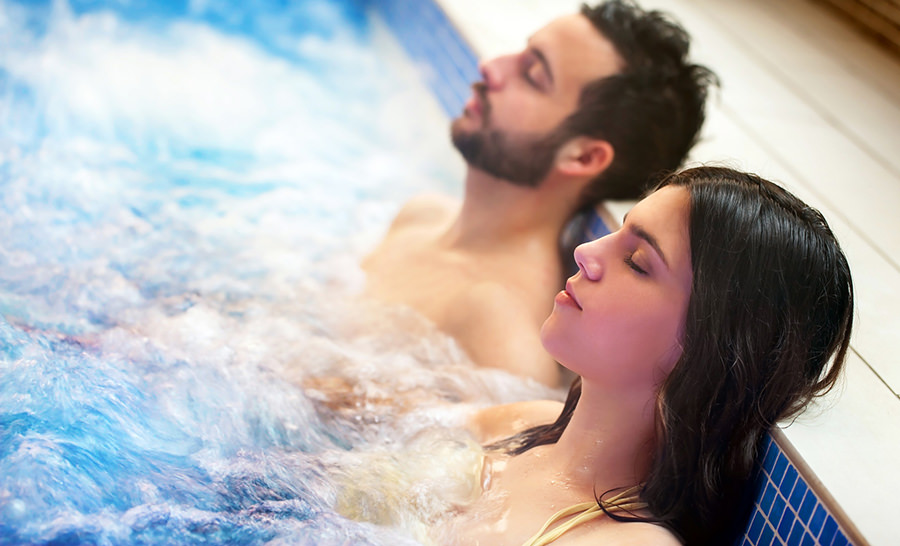
How to find the most environmentally friendly hot tub.
There are a number of things that you can do to reduce the environmental impact of your new hot tub purchase. It all starts with a good amount of research in terms of looking at what each of the manufacturers in your area offers in term of eco models. Bear in mind though that inevitably, the more eco friendly the hot tub is the chances are the more expensive it will be. If you are rather cynical you could think that this is just the manufacturers jumping in on the eco band wagon and cashing in on the opportunity but, in fact, the more economical a hot tub is to run the more it is likely to have cost to manufacture in terms of materials and technology. You will, however, in all likelihood recoup some or even all of the extra cost in terms of energy savings over the lifetime of the hot tub so, after the initial outlay the financial landscape does start to look much rosier!
Have a look at my post here for some more detailed hot tub pricing information.
So what do you need to look out for to make your new hot tub as kind to the environment as possible?
The ultimate green hot tub – In an ideal world what would the ultimate green hot tub look like? Well, just for a bit of fun I thought it might be nice to have a think about this and imagine putting it together. So, firstly it would probably need to be a wooden barrel type hot tub built either around an existing watertight container or specially built from wood cut from sustainable forests. The wood option has to be more environmentally friendly than any type of synthetic material and it is obviously recyclable at the end of the hot tub’s life. If you could find a ready-made wooden barrel that was big enough that would be awesome!
In terms of heating, a wood burning option would be appealing but not as eco-friendly as having solar heating so I guess that would be the best option. In terms of sanitization, you would need to avoid chemical systems as much as possible – either a saltwater system or ideally a UV system would be the best option.
How practical is the above super eco hot tub, or how effective would it be? I’m not sure but the chances are that most of us will buy a ready-made hot tub and want all of the added luxury touches so let’s have a look at the more realistic option of buying a ready-made eco tub!
Size matters – First of all only buy a hot tub as big as you will need it for the majority of the time. If there are only two of you it makes little sense to buy a six-person hot tub for the odd occasion when you have other people over. If you do this, not only will the purchase price be higher but the larger hot tub will hold far more water than you need and you will also have the increased energy usage to heat all of that excess water! You might think that the luxury of a large hot tub would be nice but, if your environmental concerns are a high priority, then it is a good idea to downsize.
Check what the tub is made from – Many manufacturers are moving towards rotational moulding techniques and away from heavy fibreglass and acrylic shells. The materials used in rotational moulded hot tubs are more eco-friendly as well as being tough, durable and most importantly much lighter weight which cuts down on the cost and eco-footprint of transportation. Many newer hot tub shells, as well as a large number of their components, are being specially designed to be recyclable so check out the manufacturer’s specification for details on this and make yourself aware of how much of your hot tub can be reused and how much would simply have to be dumped.
Check the energy efficiency of the hot tub – Not all hot tubs are made equal and some are much more energy efficient than others. A more energy efficient hot tub will have a significantly higher level of insulation and will, therefore, keep the water hotter for longer and so use less energy for heating. You will also find that the actual heating systems themselves vary in efficiency and the more efficient systems will use significantly less energy than a less efficient one.
This all comes at a price however and it will be the high-end hot tubs that are the most efficient. The good news is that the savings that you can make in terms of energy usage over the lifetime over the hot tub can usually more than cover the extra cost of the higher efficiency hot tub. Higher end hot tubs will be better built as well and will usually last several years longer than cheaper alternatives so, apart from the initial outlay, a high spec energy efficient hot tub will definitely be much better for the planet over it’s lifetime and is also likely to cost less over it’s lifetime as well.
You might also want to consider the option of solar powering your hot tub. Solar power kits are becoming much more common and it is possible to recoup the outlay within two to three year of regular hot tub use.
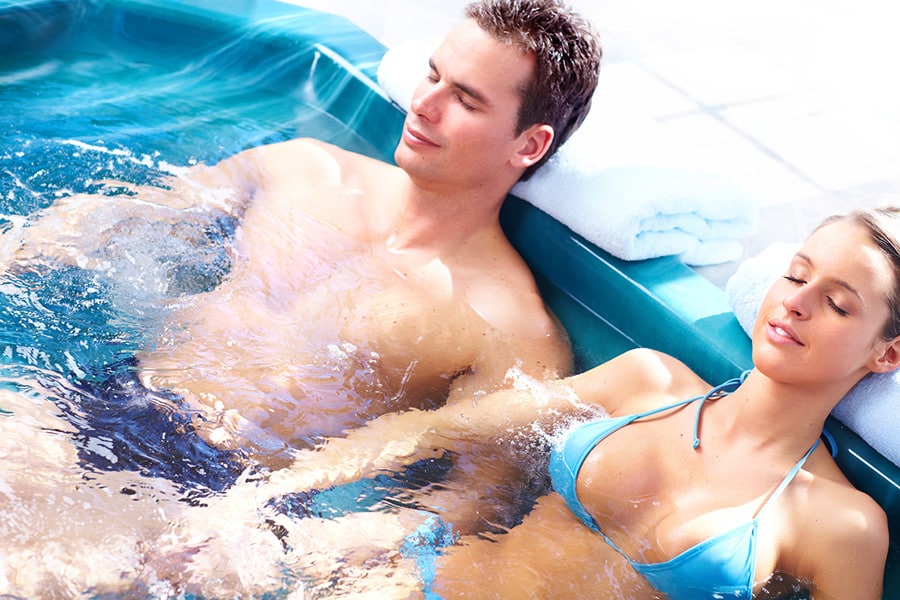
Look at alternative sanitization and filtration systems – A hot tub that has a state of the art filtration system will need less chemical interference to keep the water clean and the water will need changing less often. Less efficient filtration systems rely more heavily on chemicals to keep the hot tub clean and so are going to be less friendly to the environment. Again, there is an outlay/overall lifetime cost equation here because inevitably ultra efficient filtration system will be more expensive but it will save you a huge amount in terms of the outlay for chemicals over the lifetime of the hot tub.
It’s also very worthwhile looking at alternative sanitization systems such as saltwater systems, ozonators, ionizers and UV systems as all of these use little or no chemicals at all. Again they are most likely going to be more expensive in terms of initial outlay but the payback comes in terms of environmental friendliness and less regular financial outlay for chemicals.
How to make your hot tub better for the environment
If you already have a hot tub and are becoming more environmentally conscious what steps can you take to lessen the impact of your hot tub on the environment? You will be glad to know that most of the steps below are aimed at making your hot tub more efficient and to use less energy and therefore also save money.
Save electricity around the home – The first thing to do is to look at your overall electricity usage and to work out if it’s possible to save some energy to offset the amount of energy that your hot tub uses. Can you use the tumble dryer less for example or change over to 100% energy efficient light bulbs? What appliances get left on when they are not in use when they could be switched off? Heating appliances use most energy so is there a more efficient way of heating your home? Turning down the thermostat by a degree or two or switching off the heating in an unused room? If you cook with electricity can you change to using fewer hobs when you cook or using the oven less? Would a slow cooker fit in with your lifestyle for example or could you utilise a microwave more? For more ideas on how to save electricity around the house check out this article here.
Change electricity supplier – The next thing to do is to have a look at your electricity bills for the past year and then work out how much you are paying per unit of electricity used. You might well be able to find a cheaper supplier if you shop around and, most importantly a supplier that supplies a percentage or is even 100% green. It can also be a good idea to have a smart meter installed along with the means to monitor your electricity usage on a daily basis as this gives you a much greater understanding of which appliances use most electricity around your home.
Change the location of your hot tub – To use less energy you need to minimise heat loss from your hot tub as much as possible. It stands to reason that if your hot tub is standing out in the open in a cold prevailing wind all the time it will use more energy to keep the water warm than if it is in a sheltered, sunny spot. Take a good long look at the location of your hot tub and think about the possibility of moving it to the warmest and most sheltered spot in your garden. You might even consider constructing some sort of shelter or outdoor building around the hot tub to keep it warm as well. Gazeebos and similar structures have the added advantage of improving privacy and keeping the elements off the hot tub occupants and will improve your hot tub experience as well as save on energy usage.
If you do move your hot tub consider standing it on insulation to prevent heat loss from the bottom into the earth as well. This is cheap and easy to do and can be a real energy saver.
Add extra insulation – Check inside the hot tub service cover and see if it might be possible to add further insulation. You can spray foam insulation into gaps or add household insulation in black bin bags. You could also consider checking beneath each of the panels around the whole hot tub if you can get access. Make sure that you don’t cover any working parts though and only add insulation where there is a suitable space.
You could also add a further layer of insulation around the hot tub in the form of fencing or a wall. You could even build a second wooden skin and fill the gap between it and the hot tub with insulation. You would have to balance the aesthetic effect with the energy-saving advantages but basically, the more insulation you can wrap around the hot tub the less energy and more environmentally friendly it will be.
Use a high-quality cover – Very often the cover supplied with your hot tub will be adequate but won’t be the most thermally efficient model. Buy the most thermal efficient cover you can afford along with a thermal blanket to float on top of the water when the hot tub isn’t in use. Hot air rises so a lot of heat is lost through the cover. In winter use a full cover to keep cold air out as much as possible.
Keep the hot tub on – or not – The general advice is to keep your hot tub on at working temperature all the time as it uses less energy to reheat from cold than it does to maintain a constant temperature. This will depend upon how often you use your hot tub – if you use it more than three days a week this is probably the best advice but, if you only use it at weekends then heating it throughout the week may not make sense. It will also depend upon the thermal efficiency of your hot tub. The best thing to do is to look carefully at your pattern of usage and then, with the help of your smart meter, experiment to find out what is the best pattern of heating for you.
However, turning the temperature down on your hot tub by a degree or so will save energy in the long term and you will probably not really notice the difference.
If you generally use your hot tub over the winter you might want to consider shutting it down for the season. In some ways this defeats the object of having the luxury of the tub but, inevitably the hot tub will use more energy to keep warm over the winter than in summer and you may well find that you use it less over the winter as well.
For more energy saving ideas head over to my post here.
Related Questions:
What eco-friendly hot tub chemicals are there? There are some so-called eco hot tub chemicals available but they do tend to be expensive and may not be particularly effective. If you want to reduce your reliance on chlorine or bromine you can use a UV system which zaps the bacteria with UV light or try an Ozonator which releases ozone into the water to kill bacteria.
Which are the most energy efficient hot tubs? The most energy efficient hot tub models will have state of the art filtration and heating systems and will usually be the top of the range models from manufacturers such as Hot Spring, Bull Frog and Master Spas. The extra financial outlay at the beginning can, in most cases be recouped over the lifetime of the hot tub and this will be much better for the environment as well.

